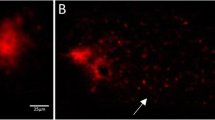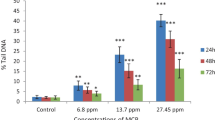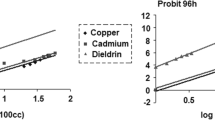Abstract
Sublethal effects of three pesticides including atrazine (triazine herbicide), DDT (organochlorinated insecticide), and chlorpyrifos (organophosphate insecticide) on acetylcholinesterase (AChE), general esterase (GE), glutathione S-transferase (GST), and cytochrome P450 monooxygenase (P450) activities were evaluated in the aquatic midge Chironomus tentans. Exposures of midges to atrazine at 30 and 150 micrograms per liter (μg/L) for 20 d (i.e., from the first- to fourth-instar larvae) enhanced P450 O-deethylation activity by 12.5- and 15.5-fold, respectively, but did not significantly change AChE, GST, and GE activities. Similar exposures to DDT at 0.01 and 0.05 μg/L did not significantly affect AChE, GE, and P450 activities; however, DDT at 0.05 μg/L enhanced GST activity toward the substrate 1-chloro-2, 4-dinitrobenzene by 33.6%. Exposures of midges to chlorpyrifos at 0.10 μg/L for 20 d reduced AChE activity by 59.8%, and GE activities toward the substrates α-naphthyl acetate and β-naphthyl acetate by 30.7 and 48.8%, respectively. The reduced GE activities appear to be due to the inhibition of several esterases, particularly the one with a slow migration, by chlorpyrifos as demonstrated by non-denaturing polyacrylamide gel electrophoresis. Furthermore, exposure of midges to chlorpyrifos at 0.10 μg/L for 20 d enhanced the P450 O-deethylation activity by 3.3-fold although no significant effect was observed at 0.02 μg/L for the same enzyme. These results provide insights into the sublethal effects of these commonly detected pesticides in aquatic environments on important enzymes in aquatic midges.

Similar content being viewed by others
References
Anderson TD, Lydy MJ (2002) Increased toxicity to invertebrates associated with a mixture of atrazine and organophosphate insecticides. Environ Toxicol Chem 21:1507–1514
Anderson TD, Zhu KY (2004) Synergistic and antagonistic effects of atrazine on the toxicity of organophosphorodithioate and organophosphorothioate insecticides to Chironomus tentans (Diptera: Chironomidae). Pestic Biochem Physiol 80:54–64
Baker DB (1998) Sediment, nutrient, and pesticide transport in selected Great Lakes tributaries. Great Lakes National Program Office, US Environmental Protection Agency, Region 5
Cooper C, Smith Jr. S, Moore M (2003) Surface water, ground water and sediment quality in three Oxbow lake watersheds in the Mississippi Delta agricultural region: Pesticides. Int J Ecol Environ Sci 29:171–184
Egaas E, Skaare JU, Svendsen NO, Sandvik M, Falls JG, Dauterman WC, Collier TK, Netland J (1993) A comparative study of effects of atrazine on xenobiotic metabolizing enzymes in fish and insect, and in in vitro phase II atrazine metabolism in some fish, insects, mammals, and one plant species. Comp Biochem Physiol 106:141–149
Ellman GL, Courtney KD, Andres V, Featherstone RM (1961) A new and rapid colorimetric determination of acetylcholinesterase activity. Biochem Pharmacol 7:88–95
Faroon O, Harris MO, Llados F, Swarts S, Sage G, Citra M, Gefell D (2002) Toxicological profile for DDT, DDE, and DDD. US Department of Health and Human Services, Atlanta, GA
Gianessi LP (1998) Benefits of triazine herbicides. In: Ballantine LG, McFarland JE, Hackett DS (eds) Triazine herbicides risk assessment. American Chemical Society, Washington, DC. pp 1–8
Gianessi LP, Puffer C (1994) Herbicide use in the United States, resources for the future. US Government Printing Office, Washington, DC
Hayaoka T, Dauterman C (1982) Induction of glutathione S-transferase by phenobarbital and pesticides in various house fly strains and its effect on toxicity. Pestic Biochem Physiol 7:113–119
Hodge S, Longley M, Booth L, Heppelthwaite V, O’Halloran K (2000) An evaluation of glutathione S-transferase activity in Tasmanian lacewing (Micromus tasmaniae) as a biomarker of organophosphate contamination. Bull Environ Contam Toxicol 65:8–15
Hopkins EH, Hippe DJ, Frick EA, Buell GR (2000) Organophosphorus pesticide occurrence and distribution in surface and ground water of the United States, 1992-1997. US Geological Survey Open-File Report 00-187. US Geological Survey, Reston, VA
Hyne RV, Maher WA (2003) Invertebrate biomarkers: Links to toxicosis that predict population decline. Ecotoxicol Environ Saf 54:366–374
Ibrahim H, Kheir R, Helmi S, Lewis J, Crane M (1998) Effects of organophosphates, carbamates, pyrethroid and organochlorine pesticides, and a heavy metal on survival and cholinesterase activity of Chironomus riparius Meingen. Bull Environ Contam Toxicol 60:448–455
Jin-Clark Y, Lydy MJ, Zhu KY (2002) Effects of atrazine and cyanazine on chlorpyrifos toxicity in Chironomus tentans (Diptera: Chironomidae). Environ Toxicol Chem 21:598–603
Johnson (1993) Mechanisms of and biomarkers for acute and delayed neuropathic effects of organophosphorus esters. In: Travis CC (ed) Use of biomarkers in assessing health and environmental impacts of chemical pollutants. NATO ASI Series, Plenum Press, New York, pp 169–182
Kello D (1989) WHO drinking water quality guidelines for selected herbicides. Food Addit Contam 6:579–585
Larson SJ, Gilliom RJ, Capel PD (1999) Pesticides in streams of the United States: Initial results from the National Water-Quality Assessment program. US Geological Survey Water Resources Investigations Report 98-4222, US Geological Survey, Sacramento, CA
Londono DK, Siegfried BD, Lydy MJ (2004) Atrazine induction of a family 4 cytochrome P450 gene in Chironomus tentans (Diptera: Chironomidae). Chemosphere 56:701–706
Plapp FW, Casida J (1970) Induction by DDT and dieldrin of insecticide metabolism by house fly enzymes. J Econ Entomol 63:1091–1092
Pratt JR, Melendez AE, Barreiro R, Bowers NJ (1997) Predicting the ecological effects of herbicides. Ecol Appl 7:1117–1124
Rakotondravelo ML (2004) Sublethal effects of three pesticides on the aquatic midge, Chironomus tentans (Diptera: Chironomidae). M.S. thesis, Kansas State University, Manhattan, KS
Richards RP, Baker DB (1993) Pesticide concentration patterns in agricultural drainage networks in the Lake Erie basin. Environ Toxicol Chem 12:13–26
SAS Institute (1996) SAS®/STAT User’s Guide: Vers 6.12, Cary, NC
Smith PK, Krohn RI, Hermanson GT, Mallia AK, Gartner FH, Provenzano MD, Fujimoto EK, Goeke NM, Olson BJ, Klenk DC (1985) Measurement of protein using bicinchoninic acid. Anal Biochem 150:76–85
Solomon KR, Baker DB, Richards RP, Dixon KR, Klaine SJ, LaPoint TW, Kendall RJ, Weisskopf CP, Giddings JM, Giesy JP, Hall LW, Williams WM (1996) Ecological risk assessment of atrazine in North American surface waters. Environ Toxicol Chem 15:31–76
Stumpf N, Nauen R (2001) Cross-resistance, inheritance, and biochemistry of mitochondrial electron transport inhibitor-acaricide resistance in Tetranychus urticae (Acari: Tetranychidae) J Econ Entomol 94:1557–1583
Thurman EM, Goolsby DA, Meyer MT, Mills MS, Pomes ML, Koplin DW (1992) A reconnaissance study of herbicides and their metabolites in surface water of the Midwestern United States using immunoassay and gas chromatography/mass spectroscopy. Environ Sci Technol 26:2440–2447
US EPA (1994a) Pesticide industry sales and usage: 1992 and 1993 market estimates. EPA-733-K-94-001, Office of Prevention, Pesticides, and Toxic Substances, US Environmental Protection Agency, Duluth, MN
US EPA (1994b) Methods for measuring the toxicity and bioaccumulation of sediment-associated contaminants with freshwater invertebrates. EPA-600-R—94-024, Office of Research and Development, Duluth, MN
US EPA (2000) Reregistration eligibility science chapter for chlorpyrifos: Fate and environmental risk assessment chapter. US Environmental Protection Agency, Washington, DC
Van Metre PC, Callender E, Fuller CC (1997) Historical trends in organochlorine compounds in river basins identified using sediment cores from reservoirs. Environ Sci Technol 31:2339–2344
Zhu KY, Brindley (1992) Significance of carboxylesterases and insensitive acetylcholinesterase in conferring organophosphate resistance in Lygus hesperus populations. Pestic Biochem Physiol 43:223–231
Zhu KY, Gao J-R (1998) Kinetic properties and variability of esterase in organophosphate-susceptible and -resistant greenbugs, Schizaphis graminum (Homoptera: Aphididae). Pestic Biochem Physiol 62:135–145
Zhu KY, Gao J-R, Starkey SR (2000) Organophosphate resistance mediated by alterations of acetylcholinesterase in a resistant clone of the greenbug, Schizaphis graminum (Homoptera: Aphididae). Pestic Biochem Physiol 68:138–147
Zhu KY, Lee SH, Clark JM (1996) Validation of a point mutation of acetylcholinesterase associated with azinophosmethyl resistance and reduced fitness in Colorado potato beetle by polymerase chain reaction coupled to enzyme inhibition assay. Pestic Biochem Physiol 57:100–108
Acknowledgments
We thank Sharon R. Starkey for her technical assistance and Yoonseong Park for reviewing an earlier version of the manuscript. This research was partially supported by the USDA NRI program through Southern Illinois University-Carbondale and the Kansas Agricultural Experiment Station, Kansas State University, to K.Y.Z. and a Fulbright scholarship to M.R. This article is contribution No. 06-55-J from the Kansas Agricultural Experiment Station. The Chironomus tentans voucher specimens (110) are located in the Museum of Entomological and Prairie Arthropod Research, Kansas State University, Manhattan, Kansas, USA.
Author information
Authors and Affiliations
Corresponding author
Rights and permissions
About this article
Cite this article
Rakotondravelo, M.L., Anderson, T., Charlton, R.E. et al. Sublethal Effects of Three Pesticides on Activities of Selected Target and Detoxification Enzymes in the Aquatic Midge, Chironomus tentans (Diptera: Chironomidae). Arch Environ Contam Toxicol 51, 360–366 (2006). https://doi.org/10.1007/s00244-005-0227-0
Received:
Accepted:
Published:
Issue Date:
DOI: https://doi.org/10.1007/s00244-005-0227-0




